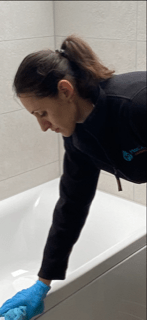Before you begin
Check the label or instruction booklet and follow any manufacturer’s recommendations; not every toy is the same, so ensuring you have everything is always good. Check any cleaning solutions on a small, inconspicuous area first to ensure it doesn’t cause discolouration or other damage. Use gloves when using any bleach products to disinfect your child’s toys. Turn off interactive toys and remove batteries before cleaning. Use bleach in an undiluted form to clean any children’s toys. Don’t give children their toys back before ensuring they are rinsed off.
How to clean toys with bleach
Fill a bowl or bucket with hot water and add a squirt of washing-up liquid. Remove the batteries if it’s an interactive toys and dip a soft cloth into soapy water; use the material to wipe down the toy, avoiding the battery compartment. Never submerge the toy in water. Mix a paste of equal parts baking soda and water. Use a cotton bud to apply the paste to the battery terminals. Leave for a few minutes, then use a toothbrush to remove all traces of baking soda. Make sure the toy is fully dry before replacing the batteries.
Bath toys
For toys such as bath toys which do not have batteries, you need to wash them first. Leave the plastic toys to soak in the soapy water for 10 minutes; gently remove any visible dirt using a soft-bristled brush. Rinse well with cold, plain water. After each bath, squeeze as much water from the toys as possible. Set them along the side of the tub or somewhere else where they can dry even faster. The most prominent place for mould to grow is inside bath toys. Moisture can build up on the inside and increase there. This means traces of mould enter the water the next time you use this toy at bathtime. If you have a problem with this, you can quickly seal the hole with a dab of hot glue.
Disinfecting the toys
Next, you’ll want to disinfect the toys, always wear gloves for this stage. Follow the manufacturer’s instructions to clean the toys using bleach. Always dilute the solution, and never use undiluted bleach on children’s toys. Use clean, plain water to rinse the toys thoroughly. Ensure that no bleach residue is left behind. Wooden toys are made from natural products, so it’s essential to take extra care when cleaning and disinfecting them. Natural products clean natural toys best. We recommend white vinegar or apple cider vinegar diluted with water. All you need to do is dip a soft cloth into the solution and wipe the surface of your toy. They leave the toy in the sun. UV is a great way to kill off any leftover bacteria, but don’t leave the wooden toy out too long, as this could lead to colour fading.
Cleaning teddy bears
Whether you want to know how to clean a very old teddy that you’re passing on from your childhood or you’ve brought something from the local charity shop. The first step for washing cuddly toys is to ensure you check the care label and always follow the advice provided. If you notice any loose threads, holes or other damage, fix these first. Next, follow these instructions for how to wash a plush toy in the washing machine. Always use a mild, child-safe, non-bio laundry detergent such as Persil. Place your soft toy inside a mesh laundry bag or pillowcase. Use a gentle, cold cycle to wash the soft toys. If you can’t wash your soft toys inside the washing machine, you may want to know how to clean teddy bears with baking soda. Sprinkle the layer of baking soda over the material of the soft toy. Place the teddy bear or soft toy into a zip-up plastic bag or pillowcase, ensuring the top is sealed. Shake the bag for a few minutes. Leave the soft toy inside the bag for 20-30 minutes. Once the time is up, remove the stuffed toy from the bag and shake off any remaining baking soda.


